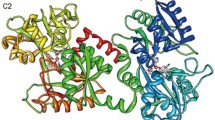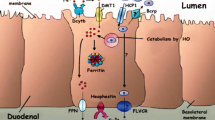Abstract
Lactoferrin (Lf - α) is a major constituent of the secondary granules of neutrophils. and is thought to be involved in bacteriostasis through high affinity binding of plasma Fe required for microbial growth. Lf - α is also the major Fe binding protein hi milk. Fe bound to Lf - α is available for metabolic use, but the mechanism of Fe release from Lf - α is unknown. Treatment of human Lf - α with neuraminidase to remove sialic acid residues reduced its ability to bind Fe and caused release of Fe already bound to the protein. Reduction in Fe binding capacity was dependent on tune of exposure to and concentration of neuraminidase, and was not due to Lf - α loss or degradation. Readdition of sialic acid to desialylated Lf - α using α - 2, 6 - sialyltransferase restored Fe binding. The results suggest that sialylation — desialylation reactions could play a role in physiologic binding and release of Fe from the very high affinity binding sites of Lf-α.
Similar content being viewed by others
References
Aisen P, Listowsky I. Iron transport and storage proteins. Ann Rev Biochem 1980; 49:357.
Moguilevsky N, Retegui LA, Masson PL. Comparison of human lactoferrin from milk and neutrophilic leucocytes. Relative molecular mass, isoelectric point, iron -binding properties and uptake by the liver. Biochem J 1985; 229: 353.
Bluard-Deconinck JM, Williams J, Evans RW, et al. Masson PL; Iron - binding fragments from the N - terminal and C - terminal regions of human lactoferrin. Biochem J 1978; 171:321.
Broxmeyer HE. Biomolecule - cell interaction and the regulation of myelopoiesis. Int J Cell Cloning 1986; 4:378.
Furmanski P, Li ZP, Fortuna MB, et al. Multiple molecular forms of human lactoferrin. Identification of a class of lactoferrins that possess ribonuclease activity and lack iron - binding capacity. J Exptl Med 1989; 170: 415.
Wei X, Nuss J, Rado TA. Characterization of the complete cDNA sequence of human neutrophil lactoferrin and isolation of genomic clones (abstr). Blood 1988; 72: 155a.
Matsumoto A, Yoshima H, Takasaki S, et al. Structural study of the sugar chains of human lactoferrin: Finding of four novel complex - type asparagine - linked sugar chains. J Biochem 1982; 91:143.
Spik G, Coddeville B, Montreuil J: Comparative study of the primary structures of sero -, lacto - and ovotrans - ferrin glycans from different species. Biochimie 1988; 70: 1459.
Winterbourn CC, Molloy AL. Susceptibilities of lacto - ferrin and transferrin to myeloperoxidase - dependent loss of iron - binding capacity. Biochem J 1988; 250:613.
Irie S, Minguell JJ, Tavassoli M. Comparison of desialylation of rat transferrin by cellular and non - cellular methods. Biochem J 1989; 259:427.
Metz-Boutique M - H, Jolles J, Mazurier J, et al. Human lactotransferrin; Amino acid sequence and structural comparison with other transferrins. Eur J Biochem 1984; 145:659.
Anderson BF, Baker HM, Dodson EJ, et al. Structure of human lactoferrin at 3.2 A resolution. Proc Natl Acad Sci USA 1987; 84:1769.
Yamada Y, Amagasaki T, Jacobsen DW, et al. Lactoferrin binding by leukemia cell lines. Blood 1987; 70:264.
Moguilevsky N, Retegui LA, Courtoy J, et al. Uptake of lactoferrin by the liver. III. Critical role of the protein moiety. Lab Invest 1984; 50:335.
Petren S, Vesterberg O, The N - acetylneuraminic acid content of five forms of human transferrin. Biochim BiophysActa 1989; 994:161.
Regoeczi E, Chindemi PA, Debanne MT. Transferrin glycans; A possible link between alcoholism and hepatic siderosis. Alcoholism 1984; 8:287.
Storey EL, Anderson GJ, Mack U, et al. Desialylated transferrin as a serological marker of chronic excessive alcohol ingestion. Lancet 1987; 1:1292.
Irie S, Kishimoto T, Tavassoli M. Desialation of transferrin by rat liver endothelium. J Clin Invest 1988; 82:508.
Author information
Authors and Affiliations
Additional information
This work was supported by National Institutes of Health Grants (Ca - 33188, Ca - 43174 and Ca - 48077).
Rights and permissions
About this article
Cite this article
Li, Z., Furmanski, P. Role of sialic acid residues in iron binding by human Lactoferrin - α. Chin J Cancer Res 7, 79–85 (1995). https://doi.org/10.1007/BF03014401
Accepted:
Issue Date:
DOI: https://doi.org/10.1007/BF03014401




